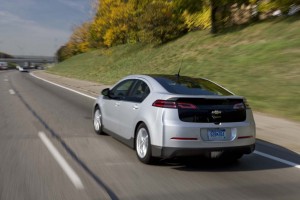Let’s cut to the chase: The Chevy Volt is as safe as any other vehicle on the road. And if something in the vehicle is going to cause a fire, it’s more likely to be its gasoline engine and associated plumbing than the groundbreaking car’s lithium-ion battery.
Still, General Motors finds itself having to defend the world’s first extended-range electric vehicle.
The controversy stems from a crash test of the Volt conducted by the National Highway Traffic Safety Administration last June. Two weeks after the test, a fire started when the battery’s coolant leaked onto a circuit board. The coolant was able to reach the circuit board on top of the battery when the agency did what it calls a rotisserie test, which simulates what might happen in a rollover crash.
NHTSA let the vehicle sit, without following GM’s protocol for draining the battery after a crash. GM has conducted demonstrations around the country to show emergency personnel how to make the battery safe after a crash.
GM and NHTSA engineers had to try several times to recreate the fire before finding success.
So, let’s see if we have this right. NHTSA crashed a Volt, rolled it, then let it sit for two weeks without following protocol for disarming the car’s 16 kWh battery. A fire started – one GM and NHTSA engineers had a hard time reproducing – even when they were trying to start one.
Here’s the really important part: No Volt owners have experienced a fire in the real world.
Still, pundits, journalists and a public that is suspicious of any car that breaks from the tradition of a century of petroleum-fueled automobiles have branded the car unsafe.
So what has GM’s response been? Overreaction. This is a company known for botching cool new technology, but this time, the General is doing all it can to handle the situation correctly, even if it means going a bit overboard.
GM offered loaners to any Volt owners who were afraid of their cars and even offered to buy back the cars if that’s what it took to keep the buyer happy.
And on Wednesday, GM CEO Dan Akerson testified before a U.S. House panel, saying the company didn’t design the Volt to be a “political punching bag.”
Ask any firefighter about the danger of driving a traditional car with its gasoline engine, tank full of several gallons of gasoline and the associated plumbing that connect the two. Still, this hasn’t caused drivers to abandon their gasoline-powered cars to go back to the horse and buggy.
NHTSA briefly opened an investigation into the fires, then closed it after GM voluntarily chose to reinforce the Volt’s battery compartment to help avoid intrusions into the battery pack.
The Volt is a revolutionary vehicle, one virtually every other automaker in the world is feverishly working to replicate. Extended-range electric vehicles like the Volt could represent a major part of the future of personal mobility because of the way they combine gasoline-free operation with the freedom of a gasoline-powered car.
Akerson said GM will have to go to work rebuilding the public’s confidence in the Volt. That effort begins right here. Someday, people will realize a Volt is no more likely to catch fire than any other car on the road.


Thank you for this opinion piece. I am still fuming at Darrell Issa and his minions for their demagoguery on this issue. Your opinion piece here certainly helps balance an article published a month or so back in our local newspaper by conservative columnist Susan Stamper Brown, in which she not only mentioned the Volt’s supposed battery fire issues but also used partial and unsubstantiated reports of Volt batteries overheating while they were charging, supposedly burning down a couple of houses, one in the Charlotte NC area. After thorough investigation by GM, the charger’s manufacturer and the local and state fire marshalls, it was found that other causes outside of the house and garage were to blame, but Brown never made the correction, even after I had written her personally criticizing her “reporting.” And for that matter, neither did our local newspaper, even after several heated e-mails between myself and the editor. He did offer me a “letter to the editor” but I declined; I did not have the necessary citations to rebut the article, and would have have probably done more harm than good, and besides, it is my firm belief that if a newspaper publishes either false or misleading information, than it is the newspaper’s place to make the necessary corrections I thank you for this article, and if it could some how find its way to the desk of the editor of The Anderson (IN) Herald Bulletin, I’d thank you. The editor doesn’t take me seriously; maybe he would be more inclined to listen to a professional journalist. Thank you so much.
Please send us a copy of the article you refer to and the contact information for the paper. We’ll follow up.
Paul A. Eisenstein
Publisher, TheDetroitBureau.com